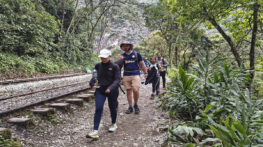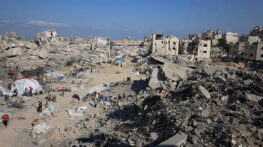
On 7 September 2017, newly arrived Rohingya refugees walk ashore at Shamlapur beach in Cox's Bazar district, Chittagong Division in Bangladesh, after traveling for 5 hours in a boat across the open waters of the Bay of Bengal. By 5 September 2017, more than 146,000 Rohingya refugees fled across the border from Rakhine State, Myanmar, into Cox's Bazar district, Chittagong Division in Bangladesh since 25 August. As many as 80 per cent of the new arrivals are women and children. More than 70 000 children need urgent humanitarian assistance. More than 100,000 of the newly arrived refugees are currently residing in makeshift settlements and official refugee camps that are extremely overcrowded while 10,000 newly arrived refugees are in host communities. In addition, 33,000 arrivals are in new spontaneous sites, which are quickly expanding. While some refugees are making their own shelters, the majority of people are staying in the open, suffering from exhaustion, sickness and hunger. Cox’s Bazar district of Bangladesh is one of the most vulnerable districts, not only for its poor performance in child related indicators but also for its vulnerability to natural hazards. Most people walked 50 or 60 kilometers for up to six days and are in dire need of food, water and protection. Many children are suffering from cold fever as they are drenched in rain and lack additional clothes. Children and adolescents, especially girls, are vulnerable to trafficking as different child trafficking groups are active in the region. Many more children in need of support and protection remain in the areas of northern Rakhine State that have been wracked by violence. In Bangladesh, UNICEF is scaling up its response to provide refugee children with protection, nutrition, health, water and sanitation support. With the recent influx of refugees, demand has increased and UNICEF is working to mobilize more support and strengthen its existing activities. For recreational and psychosocial support to the newly arrived Rohingya children, 33 mobile Child Friendly Spaces (CFSs) are now operational with 100 recreational kits, Education in Emergency (EiE) kits and trained teachers. These mobile Child Friendly Spaces have already provided psychosocial support to 226 newly arrived Rohingya children. Separated and unaccompanied children are also being identified through Child Friendly Spaces and community outreach. Over 100 adolescent clubs are operational in host and makeshift settlements to provide life-skills education through outreach activities. In Myanmar, UNICEF does not at present have access to the affected areas in northern Rakhine State including 28,000 children who were previously provided psychosocial care or the more than 4,000 children who were treated for malnutrition in Buthidaung and Maungdaw. UNICEF’s clean water and sanitation work has been suspended, as have school repairs that were under way.
মিয়ানমারের রাখাইন রাজ্যে বসবাসকারী রোহিঙ্গা জনগোষ্ঠির ৪০ শতাংশ ২৫ আগস্টের পর থেকে গত তিন সপ্তাহে পালিয়ে বাংলাদেশে আশ্রয় নিয়েছে বলে জানিয়েছে জাতিসংঘ। বৃহস্পতিবার নিউইয়র্কে এক ব্রিফিংয়ে জাতিসংঘ মহাসচিবের মুখপাত্র স্টেফানে দুজারিক এ তথ্য জানান।
এর আগে গত বুধবার মিয়ানমার সরকারের পক্ষ থেকেও একই রকম দাবি করা হয়েছিল। দেশটির সরকারের বলেছে, রাখাইনে রোহিঙ্গাদের ৪০ শতাংশ গ্রাম এখন জনমানবশূন্য।
জাতিসংঘের শরণার্থী সংস্থার হিসাব অনুযায়ী, ২৫ আগস্টের পর থেকে বাংলাদেশে আশ্রয় নেয়া রোহিঙ্গাদের সংখ্যা ৪ লাখ ছাড়িয়েছে। পালিয়ে আসার এ হার প্রত্যেক দিন গড়ে প্রায় ২০ হাজার।
ধারণা করা হয়, ২৫ আগস্টের আগ পর্যন্ত গত কয়েক দশক ধরে রাখাইন ছেড়ে বিভিন্ন দেশে প্রায় ১২ লাখ রোহিঙ্গা আশ্রয় নিয়েছেন। আর রাখাইনে অবস্থান করছেন আরও ১০ থেকে ১১ লাখ মানুষ। এর মধ্য থেকে গত তিন সপ্তাহে পালিয়ে বাংলাদেশে আশ্রয় নেয়া ৪ লাখ মোট জনগোষ্ঠির ৪০ শতাংশের কাছাকাছি।
/কিউএস





Leave a reply